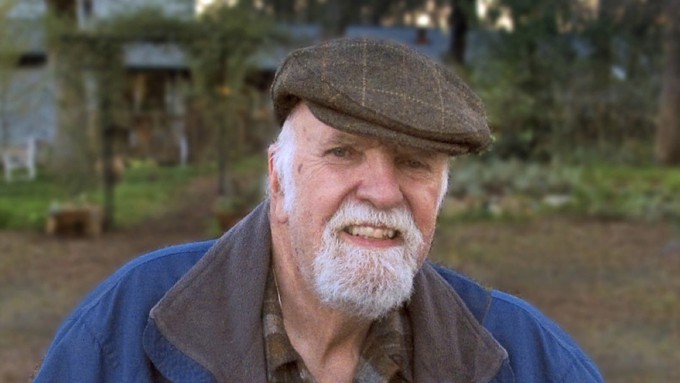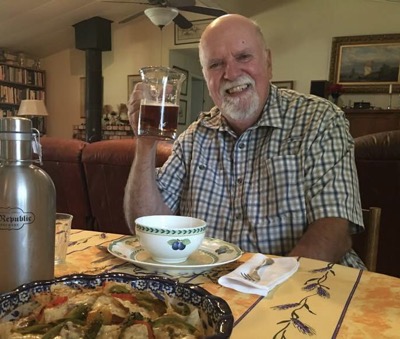
Award-winning garden writer, author helped solve backyard mysteries

Dick Tracy was the original 'Garden Detective' of The Sacramento Bee's Cal Life section. Photos courtesy Felicia Tracy
Our Sacramento gardening world recently lost a legend with the passing of Dick Tracy, the original “Garden Detective.” After a series of illnesses, he died Feb. 28 at his Grass Valley home. He was 84.
As garden writer for The Sacramento Bee, Tracy answered thousands of reader questions about what was bugging their plants and other backyard mysteries. With a ready wit and insatiable curiosity, he also tackled food dilemmas as The Bee’s “Food Sleuth.”
For The Bee’s Cal Life section, he wrote hundreds of profiles of inspirational local gardeners, capturing their excitement and unique relationships with plants.
Garden writing wasn’t his first passion; he was hired by The Bee as its farm reporter in 1969 for the long-gone “Country Life” section.
“I was shoved into the role of garden writing,” Tracy recalled while writing about his career. “The other guys said, ‘We hate gardening, so you’re the garden writer.’ ”
It was the best thing that could have happened, he added.
“Some people are born under a lucky star. I was one. Knowing absolutely nothing about horticulture, I began interviewing garden hobbyists and hoped for the best. They helped me immeasurably and appreciated what I wrote.
“And so did The Bee’s readers. At one point in my career, I was honored by a Channel 10 viewers’ poll naming their favorite newspaper columnist. The immortal Herb Caen of the San Francisco Chronicle won hands down. I came in second!”
Tracy captured the whimsy of John and Ann Morris at their Troll Knoll garden home in Penn Valley or the passion of pioneering sustainability expert Carolyn Singer. “In my opinion, gardeners are the world’s finest people,” he wrote.
While winning several national awards for his garden writing, Tracy became a UC Cooperative Education master gardener and served as Western Regional Director for the Garden Writers’ Association (now Garden Communicators International). In 1999, he was honored by the Sacramento County master gardeners as an Honorary Lifetime Master Gardener.
With Napa Valley entrepreneur Molly Chappellet, he wrote “Gardens of the Wine Country,” published by Chronicle Books. Featuring 40 gardens, the 1998 book was honored with GWA’s Quill and Trowel Award. He also judged the GWA’s publications contest for many years.
“Dick was an incredible garden writer, but to tell the truth, not much of a gardener,” said Felicia Tracy, his wife of 33 years. “But we always had a big vegetable garden.”
With an encyclopedic knowledge of plants, Dick found plenty of room to “attempt” gardening at Felicia’s 100-acre family horse ranch in Grass Valley. He had raised three sons with his first wife, Judy. Felicia also had two grown children.
Longtime friends, Dick and Felicia first dated in 1962. They got reacquainted following the death of Felicia’s first husband and married in 1989. Their blended family now includes seven grandchildren.

Said Dick, “I married a 4-H project and opened up doors I hardly knew existed. … Moving from my downtown bachelor apartment to her family horse ranch in the foothills was more proof, to my way of thinking, that a guardian angel was keeping watch over me. She loved to cook, and I loved to eat. Our lives blended perfectly.”
“He adapted to ranch life incredible well,” Felicia said. “He did everything from delivering a calf to cleaning stalls.”
Dick also discovered trap shooting and became accomplished at that, too. Another passion was his 1963 Humber Super Snipe, which he drove on pleasure drives with Felicia through the Sierra foothills.
Dick Schmidt, a retired Bee photographer, worked with Tracy for many years. “Decades ago, Reader’s Digest had a regular feature in each monthly issue: ‘The Most Unforgettable Character I Ever Met.’ For me, that’s Dick Tracy. He was the real deal,” Schmidt said.
“I so enjoyed the many years going together on Bee assignments with Dick ... to an interesting Cal Life story, frequently on the road, stopping for lunch at some far-out, off-the-path restaurant or diner,” Schmidt recalled. “Always excellent conversations, topics and back-and-forth banter.
“He retired from his 30-career at The Bee and began – at age 62! – a second full time labor-of-love on a working equestrian ranch, filled with physical activity,” Schmidt noted. “(He) often referred to himself, with pride, as Ricardo the ranch hand.”
After a severe illness almost killed him four years ago, Tracy wrote a “self-obit,” said Schmidt. “It was smoothly crafted, filled with facts and punctuated with humor.”
The lede: “Dang! I knew this would happen, eventually; I’m dead!”
“I’ve been blessed with having true friends from my school and work days, and share the love of several animals, including Duke, my beloved Visla, and Aussie-shepherd Spencer,” Tracy wrote. “It pleases me to know the people I love vastly outnumber any others and hope they remember me with a smile.
“I’m ‘spiritual’ rather than religious and don’t really believe I have a date with St. Peter at the pearly gates,” he added. “But if there is such a place as heaven, I don’t see how it could be more wonderful than my life on earth has been.”
Tracy concluded with advice from his ranching days: “Never squat when wearing spurs.”
-------------------------------------
Some more Tracy tales
Patricia Beach Smith, a longtime Bee colleague, now retired, shared these Tracy memories:
He introduced himself as Dick Tracy (oh, yeah?). Then he added, “Garden Detective — at your service.” That was 40 years ago, on the first day of my new job at The Bee. Throughout our friendship, Dick lived up to his gallant offer that day.
He took me on a lot of adventures — starting with a short trip down the hallway from our office, into the Bee cafeteria. There, he introduced me around, to the obit writer with a surprisingly wicked sense of humor, a photographer with a quiet but deadly wit, and a veteran reporter who could write a story about string and make it interesting.
There was a ride around my new town — anyway, the town he thought I should know. Capital Nursery was top of the list (and first on any Sacramento gardener’s list, too, at the time.)
Then we explored the Capitol Park Arboretum. Very impressive all by itself, but Dick enhanced the experience by knowing the name of every tree, bush and flower in park — in English and Latin. Wow! I was impressed. I’d just moved here from Michigan, where no palm trees have ever grown, much less different kinds, including the park’s Chilean Wine Palms!
Dick also whisked me off to Napa Valley one day, in his precious old roadster. I got car sick while he imitated Mario Andretti, racing around Lake Barryessa.
When we got to Napa, we saw gardens. No wine, but wineries. And gardens. Fabulous ones, the likes of which I’d never hoped to see. Gardens with dedicated croquet lawns, luscious portagers to make a French chef faint, and acres of elegantly articulated flower beds. A few years after that little journey, the best of those special gardens were captured in the pages of a book Dick wrote and photographed.
A garden closer to home, the first full-blown Japanese garden I’d ever seen, Dick showed me. This, and all of the other gardens he showed me over the years, contributed to the way I regard these living miracles, look at them more critically and appreciate them more fully.
Dick retired, but only from writing at The Bee. He dived into Nevada County ranch life with his beloved Felicia. She taught him to ride one of her horses. She baked him a mean galette or two, with fruit from their ranch and he delighted in his neighbors. Especially the one who drove this happy couple from their wedding in a beautiful carriage drawn by two sweet dapple grays.
Dick and I were friends to the end. E-mail was a great asset to our friendship, especially during the pandemic period. Our epistolary friendship was spirited and remarkably satisfying. We wrote about politics, history, life, dear Felicia, dogs and occasionally, yes, gardening.
In his last few emails to me, Dick said bluntly to “Mask up! Everywhere! Don’t be cocky. I have RSV!” He invited me to the ranch when the “Covid coast is clear,” to go through his more than 200 books on gardening. “I want to be the garden lending library! And a tour of Troll Knoll garden in Penn Valley might also be arranged,” he mused, still wanting to show me around. “Free book. I wrote it.”
Last e-mail, maybe, but certainly not the final memory of a unique, amusing and dear friend.
Comments
0 comments have been posted.Sacramento Digs Gardening to your inbox.
Food in My Back Yard Series
May 6: Maintain soil moisture with mulch for garden success
April 29: What's (already) wrong with my tomato plants?
April 22: Should you stock up on fertilizer? (Yes!)
April 15: Grow culinary herbs in containers
April 8: When to plant summer vegetables
April 1: Don't be fooled by these garden myths
March 25: Fertilizer tips: How to 'feed' your vegetables for healthy growth
March 18: Time to give vegetable seedlings some more space
March 11: Ways to win the fight against weeds
March 4: Potatoes from the garden
Feb. 25: Plant a fruit tree now -- for later
Feb. 18: How to squeeze more food into less space
Feb. 11: When to plant? Consider staggering your transplants
Feb. 4: Starting in seed starting
Sites We Like
Garden Checklist for week of May 11
Make the most of the lower temperatures early in the week. We’ll be back in the 80s by Thursday.
* Plant, plant, plant! It’s prime planting season in the Sacramento area. Time to set out those tomato transplants along with peppers and eggplants. Pinch off any flowers on new transplants to make them concentrate on establishing roots instead of setting premature fruit.
* Direct-seed melons, cucumbers, summer squash, corn, radishes, pumpkins and annual herbs such as basil.
* Harvest cabbage, lettuce, peas and green onions.
* In the flower garden, direct-seed sunflowers, cosmos, salvia, zinnias, marigolds, celosia and asters. (You also can transplant seedlings for many of the same flowers.)
* Plant dahlia tubers.
* Transplant petunias, marigolds and perennial flowers such as astilbe, columbine, coneflowers, coreopsis, dahlias, rudbeckia and verbena.
* Keep an eye out for slugs, snails, earwigs and aphids that want to dine on tender new growth.
* Feed summer bloomers with a balanced fertilizer.
* For continued bloom, cut off spent flowers on roses as well as other flowering plants.
* Add mulch to the garden to maintain moisture. Mulch also cuts down on weeds. But don’t let it mound around the stems or trunks of trees or shrubs. Leave about a 6-inch-to-1-foot circle to avoid crown rot or other problems.
* Remember to weed! Pull those nasties before they set seed.
* Water early in the day and keep seedlings evenly moist.